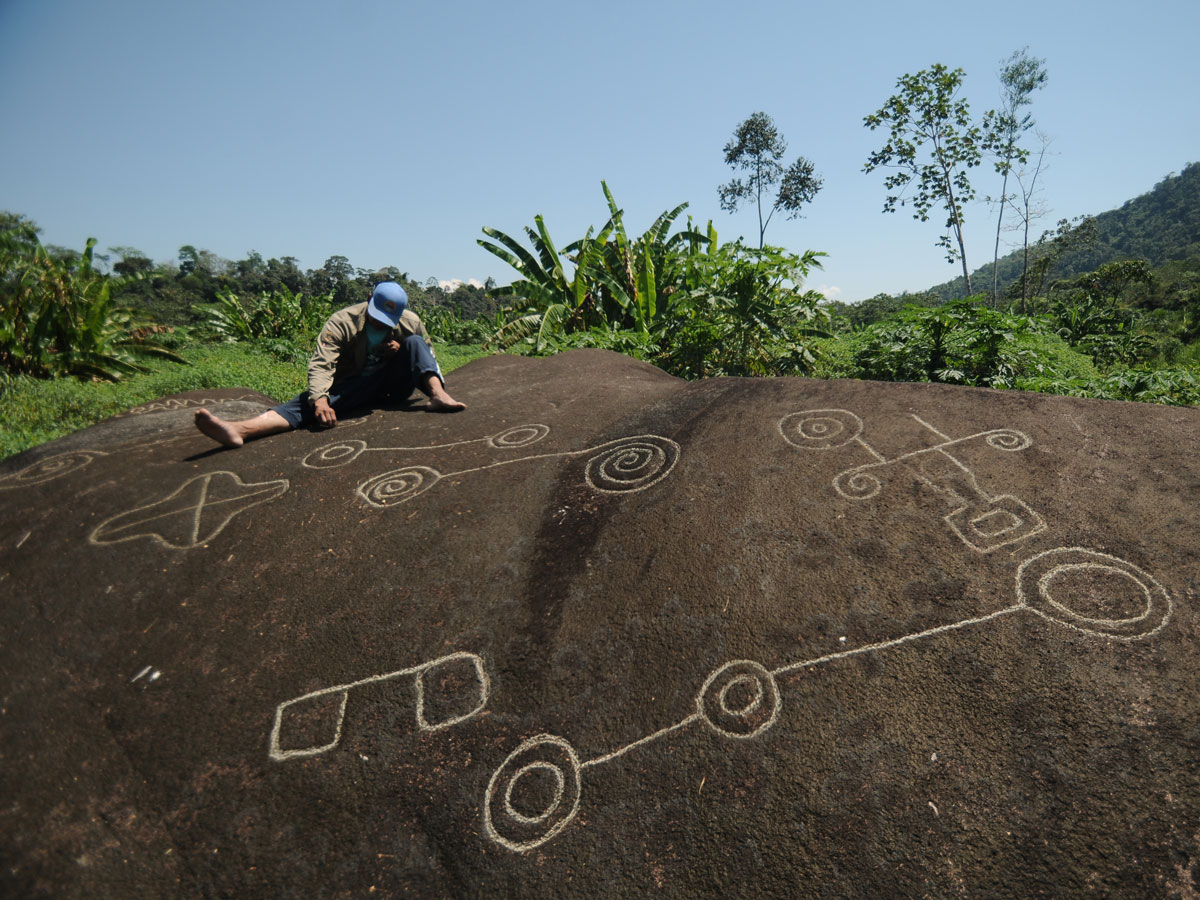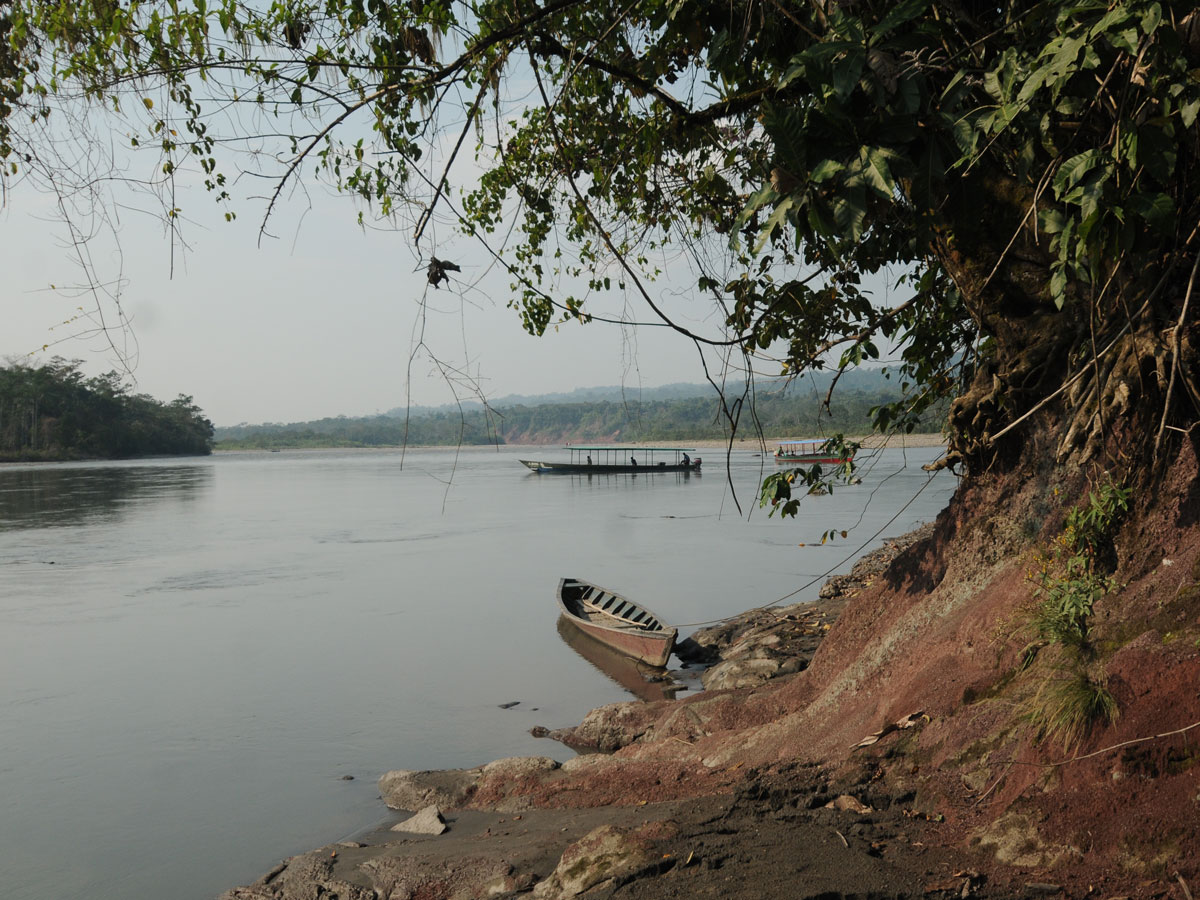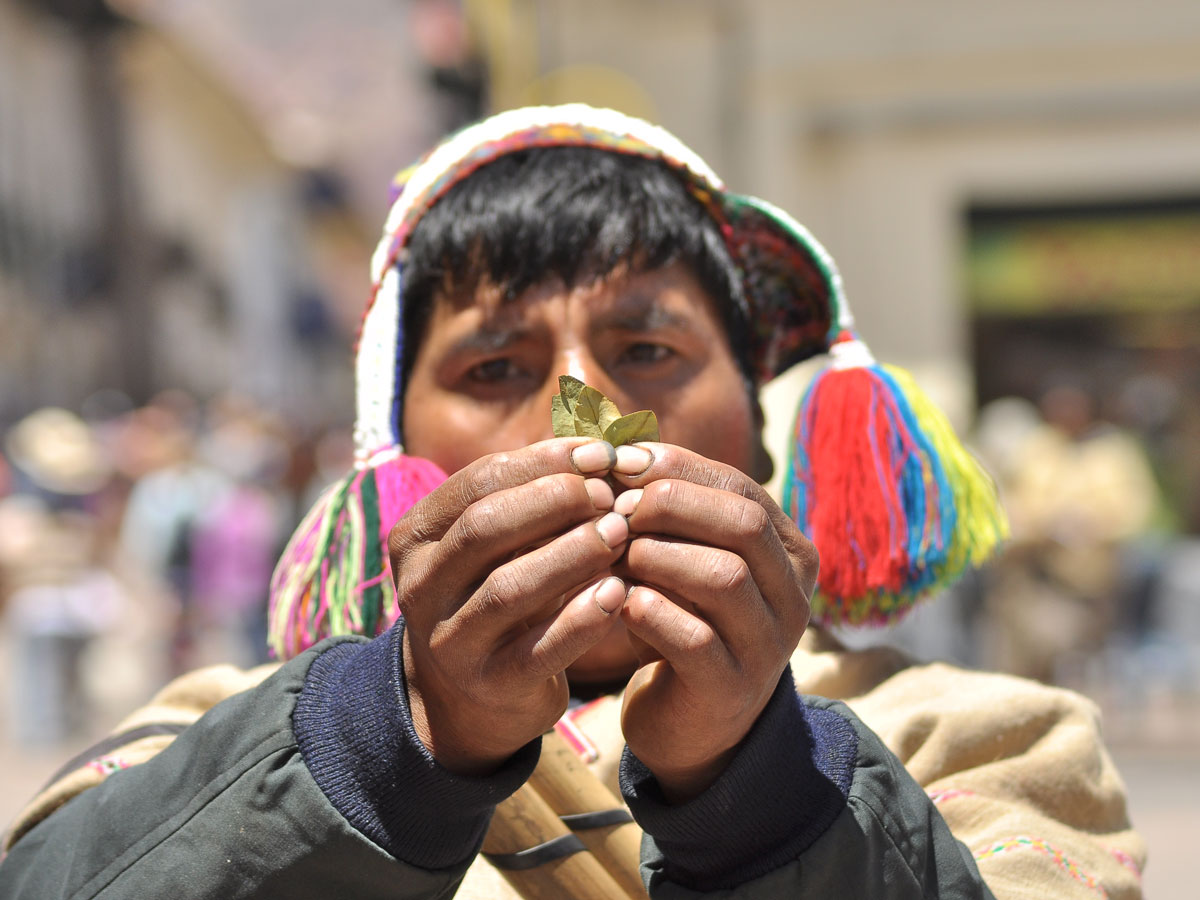
"I say truly to your highness that these people are the most insolent that i have seen in all the time that i have traveled in the indies and engaged in their conquest."
-Captain Hernando de Benavente on the jivaro indians, March 25,1550, to the royal Audiencia of spain.
It was Francisco Orellana, a spanish conquistador in Gonzalo Pizarro's expedition, who first got close up looks at Peru's Amazon indians and ultimately became the first European to float 3,500km (2,200 miles) down the amazon river.
Four years after Francisco Pizarro had brought the inca empire to its knees, in 1540 the elder Pizarro dispatched his younger brother Gonzalo to seek out rumors of an empire of gold to the east-the legend of El Dorado. Leaving what is now Quito, Ecuador with a vast expedition that included over 200 spaniards, 4000 indian slaves, horses and flocks of llamas and pigs, the conquistadors headed over the Andes and down through the cloud forest before constructing a boat and floating down what is now the Napo river. It was not long before they came upon the inhabitants of this mysterious, dripping world. He later recalled:
"..we saw coming up the river a great many canoes, all equipped for fighting, gaily colored, and the men with their shields on, which are made out of the shell-like skins of lizards and the hides of manatees and of tapirs..they were coming on whit a great yell, playing on many drums and wooden trumpets, threatening us as if they were going to devour us."
Unlike the younger Pizarro, Orellana was anthropologically astute. Separating from Gonzalo's party which would later return to Quito, Orellana Learnet several Indian dialects as he descended, kept his men from killing them, and questioned the Indians at length. Eventually, after a voyage of nine months, Orellana and his men sailed from the mouth of the amazon and returned to Peru via Panama. One and a half years after the expedition had begun, Gonzalo Pizarro and a ragged crew stumbled into Quito. Only 80 of the original 4,200 men had survived.

The Amazon indians have long played a part in Peruvian history. According to inca oral history, hordes of fierce jungle indians were said to have climbed into the Andes and to have sacred the Inca capital of Cusco several times. Indeet, the inca fortress of Pisac is through to have been an outpost protecting the capital from the attack of the feared jungle tribes to the east. The incas themselves referred to the eastern quarter of their 4,500-km long empire as antisuyo, and to the Indians who lived in its jungles as the antis; it is from the latter word that the name Andes derives.
When not warring, trade was routinely carried out between the incas and the antis, the former trading cloths, manufactured goods and bronze axes in return for gold, feathers, exotic fruits, woods and other jungle products. After the empire was sacked by the spaniards one of the last inca kings, Manco Capac, fled from Cusco and esrtablished a new capital deep in the jungle in Vilcabamba (the lost capital was rediscovered in 1964 by the American explorer gene savoy). Manco Capac was aided by legions of loyal jungle warriors who were deadly with bow and arrow.
After the collapse of the incas, the jungle was largely abandoned by the spaniards who concentrated on mining wealth from the more tractable peasants in the andes and on the coast.The few expeditions mounted into the jungle generally met with disaster. In a few cases, such as among the fierce, headshrinking jivaro indians living in northern Peru, the spaniards did establish jungle towns and attempted to tax the indians increasing quantities of gold.In 1599, however, the jivaros staged a massive revolt, burning and sacking the cities and slaughtering an estimated 20-30,000 men, women and children.
They then captured the spanish governor who happened to be on a tax-collecting mission at the time.
"They stripped him naked, tied his hands and feet; and while some amused themselves with him, delivering a thousand castigations and jests. The others set up a large forge in the courtyard, where they melted the gold.When it was ready in the crucibles.They opened his mouth with a bone, saying that they wanted to see if for once he had enough gold.They poured it little, and then forced it down with another bone, and bursting his bowels with the torture, all raised a clamor and laughter."
In southern Peru, the spaniards did't fare much better.An expedition mounted to explore the Madre de Dios and Manu rivers encountered numerous hostile indians. A second spanish expedition was launched, after convincing the authorities that the first had no legal right to conquer new empires. When they met, the two groups nearly annihilated each other. Whereupon the ever watchful indians massacred all but two of the survivors.
DECIMATED BY DISEASE: From then on for Peru's Indians, however, it was all downhill.
As elsewhere, their greatest nemesis was not so much the spaniards as it was the introduction of European diseases. Having crossed the bering straight out of Asia anywhere from 10-40,000 years ago, the new world Indians inmunological systems were totally unprepared for European pathogens. The inca empire, for example, which is thought to have had about 7 million indians at the time of the spanish contract, had less than 2 million fifty rears later. The same pattern was repeated in the jungle, beginning in the zone of greatest contact-the amazon and its major tributaries-and gradually working its way into deeper parts of the forest. Slaves raiding, which started on Brazil's coast in the 16th century, gradually worked its way further and further into the upper amazon and Peru. Within a hundred years of orellana's descent, the "teeming indians" that had once infested the amazon's banks were nowhere to be seen.Indian tribes that hadn't been captured further into the jungle's interior.

The biggest incursion into Peru's amazon, however, didn't occur until the rubber boom exploted in the late 19th century almost overnight, the most isolated jungle rivers and streams were overrun by rubber tappers who carried the latest winchester carbines. Rubber trees were few and far between-hence rubber tapping demanded intensive labor. Entire indian villages were therefone sacked to capture indian slaves. In the case of especially hostile tribes, correrias, or armed raids, were carried out in which villages and indians were surrounded and slaughtered by the employees of the great rubber barons. Whole areas of the amazon were thus wiped clear of native populations in a matter of decades.
In 1912, however, the rubber market began to collapse and this time, almost overnight the rubber tappers withdrew, haltingly, the remaining tribes were left alone except for occasional missionaries.In the 1960's as the peasants in the andes became more numerous,Peru's government-burdened by hordes of peasants moving into the coastal cities and unwilling to enact land reform in the sierra chose the easier alternative and began encouraging these peasants to move into the vast, unsettled amazon which makes up two-thirds of the country. A north-south marginal highway was bulldozed through the jungle to encourage settlement and soon impoverished Peruvians began to pour in.
The extraction of hardwood trees-mahogany, cedar and caoba-repeated the pattern of the rubber boom as peons bankrolled by wealthy patrons once again moved into the virgin forest looking for quick extractable wealth. Gradually, one by one, isolated Indian tribes were contacted by missionaries, woodworkers and/or oil drillers. Although there were some forty uncontactedn tribes in the peruvian amazon at the turn of this century, today there are only two or three of these tribes left (all in the southeastern jungle). Today the majority of Peru's 200,000 amazon indians exist in varying stages of acculturation.
INDIAN CULTURES: Although in the 16th century there was considerable discussion in Europe as to whether the new world Indians were indeed "the sons of adam and eve" and hence deserving of the rights of real human beings, in 1512 a papal bull decreed that amazonian indians possessed souls. In later centuries scientists such as wallace, bates, Humboldt and Agassiz visited the visited the amazon and eventually anthropologists began living with different tribes and recording a bewildering variety of cultures. Today it is generally recognized that the culture of any human group is strongly influenced by its environment. Thus, while incredibly diverse, because of their unique environment amazon tribes have many features in common.
While certain areas on the Peruvian coast and mountains encouraged and supported permanent settlement and later statehood by virtue of stream valleys that renewed their soil (much as the Nile river did in Egypt), the amazon jungle is characterized in contrast as having extremely poor soils and game animals that, while diverse, are few and far between.
As a result, the typical Amazon village on the terrafirme -the inmense lands between the large rivers- are typically small (25-100 people), mobile and widely spaced out due to the jungle's low bioproductivity and to the quick exhaustion of the land.In addition, mainland tribes almost universally practiced warfare and contraception or infanticide techniques in order to keep their populations down.Thus the jivaro indians penchant for head-shrinking was simply a variation on trophy-head taking and warfare patterns widely practiced throughout the amazon.

But tribes on the varzea-the more limited floodplain areas where the soil is renewed annually-did not fight among themselves and permanent villages ranging into the thousands of inhabitans. Although battles were sometimes fought with the terra firme tribes in order to take slaves to work in varzea fields, populations control did not exist. The necessity of carefully monitoring seasonal planting pattern and river flunctuations gave rise to temples, priests complex rule and food storage.And although the varzea tribes and tribes were the first hit by contact and disease, orellana's men reported numerous varzea trives and towns with temples and roads that led off into the the interior.
Given their similar habitat, the amazon tribes had other features in common. Almost invariably, they viewed their forest and the animals in it as sacred and inbued with spirits. Most Peruvian trives took one or more hallucinogenic drugs such as avahuasca, the "vine of death", which allowed them to see and interact with the powerful spiritual world. The forest was their provider their mother and was not to be abused.
Even today, most scientists concede that no one understands the jungle better than the remaining indians. For thousands of years they have lived in the jungle harmoniously, and while they do not posses our own overwhelmingly more powerful technology, they also do not possess our almost complete lack of understanding and irreverence for this most complex habitat on earth.
A PEOPLE LEFT IN LIMBO: Currently there are some 200,000 native indians in the Peruvian Amazon divided into 53 different ethnic groups and speaking languages from 12 diferent linguistic families.Some groups, such as the toyeri in southern Peru are composed of only a handful of surviving families, others, such as the Machiguenga and campa, living in the jungles east of Machu Picchu and who are thought to have been the allies of the incas, number in the tens of thousands.
Unike Brazil, which has a governmental entity (FUNAI) to regulate indiuan affairs, jungle indians in Peru have little governmental support. Legislation allowing Indian communities to possess land was only passed in 1974. Over 30 native organizations have sprung up in the last two decades as different Indian groups have gradually realized that only by putting aside histortical enmities and organizing can their rigthts be defended or secured.
Despite increasing organization, however, Peru's Amazon indians continue to exist in a social and legal limbo. At best they are seen as a hindrance to a government whose goal is to "develop" the Amazon. Enormous pressure on the part of the national society, missionaries an the education system encourages indians to reject their own culture and become deracinated Peruvian citizens. The US protestant missionary group, the summer Institute of linguistics (SIL) has a large airbase just outside of the jungle town of Pucallpa and has worked with dozens of trives since 1946. Although the SIL has nursed a number of recently-contacted tribes through contac-induced epidemics, they and a host of other missionaries have had an enormous acculturative impact. In a very real sence, because of the Peruvian government's historical lack of interest, foreign missionary groups have been relegated the job of contacting and integrating Peru's jungle indians into the national culture.
Some cultures, however, seem to withstand or assimilate acculturation better than others. The numerous shipibo indians living in central Peru along the Ucayali river have despite long historical contac maintained much of their traditional culture. They even operate a Shipibo-owned cooperative store.(Moroti shovo in Yarinacocha, just outside of Pucallpa), where they sell and export their exceptionally high-quality weavings and pottery to museums and collectors all over the world.In 1990 the Ashanika indians, living on the ene river, went on the warpath when the maoist shining path guerrillas killed their chief, shooting and expelling all guerrillas from their territory. Other tribes, however, have less resistance to change and have lost their cultures in a very few generations.
Tourism can have an adverse effect on native cultures, especially if poorly handled.Certain tour groups in Iquitos advertising visits to "wild Amazon indians", for instance, use completely acculturated tribes which strip down and don costumes to play the part of "savages". Other companies have been known to actually fly tourists out to relatively unacculturated indians. The latter's lack of inmunity to common colds and other diseases, along with their culture's relatively fragile nature, however, make such practices questionable. When visiting any native community, therefore, the tourist should always ask first before taking photos, should offer small presents such as fishing hooks or fishing line in return, and should when buying, pay a good price directly to the indians themselves for their handmade treaditional crafts.
For most indians, however, culture change is inevitable. As one anthropologist working in Peru's Amazon phrased it, "the indians cannot be expected to remain "pristine" and thus live somewhere where they are caged in by "white" wardens in parks. They are very curious about our world and it is inevitable that they will change. Their culture doesn't die, however, reather it reformulates itself so that it can better deal with the outside world."
